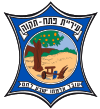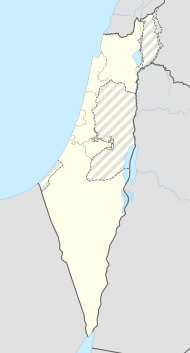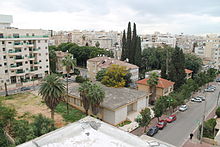Petach Tikva
| Petach Tikva | ||
|---|---|---|
|
||

|
||
| Basic data | ||
| hebrew : | פתח תקווה | |
| arabic : | بتاح تكفا | |
| State : |
|
|
| District : | Central | |
| Founded : | 1878 | |
| Coordinates : | 32 ° 5 ' N , 34 ° 53' E | |
| Height : | 15 m | |
| Area : | 35.868 km² | |
| Residents : | 244,275 (as of 2018) | |
| Population density : | 6,810 inhabitants per km² | |
| Community code : | 7900 | |
| Time zone : | UTC + 2 | |
| Postal code : | 49001-49197 | |
| Community type: | city | |
| Website : | ||
|
|
||
Petach Tikwa ( Hebrew פֶּתַח תִּקְוָה Petach Tiqwah / Petach Tiḳwah , German 'Gate of Hope' , Arabic بتاح تكفا, DMG Bitāḥ Tikfā ; in languages without the sound ch (IPA χ) , but pronunciation of the 'W' as a double U : also Petah Tikva) is a city in Israel . It is located in Gush Dan , a few kilometers east of Tel Aviv , in the central district . The Tel Aviv suburb has a population of 244,275 (2018), making it one of the largest cities in Israel .
history
The history of Petach Tikwas goes back to the 19th century. In 1878, settlers from Jerusalem established the first settlement. It was the first Jewish farmers' settlement (" moshava ") in what was then Palestine . That is why she was later given the nickname "Mother of Moshavot". However, the first founding of the town "failed due to malaria and floods". The "second successful establishment in 1882, now by immigrant Jews" coincides with the establishment of Rishon LeZion and Rosh Pina . One of the first settlers was Mordechai Diskin, an immigrant from Grodno . The settlers named the new place after Hosea 2:17: "Then I want to give her [Israel is meant] her vineyards from there and make the Achor valley the gate of hope." Tilled fields will be full of bread. "(Proverbs 12:11)
From 1888, the settlers also received support from Baron Edmond de Rothschild , who promoted many settlement projects in what was then Palestine. The settlement initially had significant problems due to crop failures and malaria . Over time, however, the malaria swamps were drained and the area became a focus of citrus fruit cultivation . Another problem arose: The transport of the harvest for export , which had to be brought quickly and fresh to the ships of the then nearest port, Jaffa , in order to be able to be exported. That could hardly be done with camel caravans on undeveloped sandy slopes. That is why the orange growers campaigned for a connection to the main railway line El Qantara - Haifa immediately after the First World War . They could not pay for such an expensive investment themselves, but Baron Edmond de Rothschild agreed to loan £ EYT 20,000 for the project. The Palestine Railways , however, insisted that the settlers guarantee at least 100 passengers a day . In contrast, these made it a condition that no traffic should take place on the Sabbath , whereupon the railroad insisted on stopping traffic on Sundays as well.
In 1921 the 6.5 km long branch line between Ras el Ain (today: Rosh HaAjin ) on the main line and Petach Tikwa went into operation after 6 months of construction. However, construction costs were £ EYT 53,000 contrary to the expected £ EYT 20,000. Therefore, the government of the mandate area participated in the investment and the railway line belonged to the Petach Tikwa community and half to the government, a condom line .
It was an immediate economic success: The cost of transporting oranges to the coast fell by more than half. Tourist traffic was also granted immediate success, as the train replaced a four to five-hour journey in an open horse-drawn wagon over an unpaved sand runway. Since travelers also took the somewhat cumbersome procedure on the railway in buying: One or two cars were appended to the freight train to Ras el Ain and there as coaches attached to the train Haifa El Qantara. In Lod , the travelers had to change trains from Jerusalem to Jaffa. Total travel time - if everything went on time - about 90 minutes. However, when the road to Jaffa was paved in 1928, it immediately put an end to travel on this connection. Busses now took over the task. Petach Tikwa grew considerably in the following years and was granted town charter in 1937. From 1940 to 1951 Josef Sapir held the office of mayor.
In Petach Tikwa there are still some historical places from the Wilhelminian era and a historical museum in the Qiryat HaMuse'onim museum complex .
Today's city
Today, Petach Tikwa is a city whose agricultural past is only reminiscent of the so-called Founder's Garden in the city center. The mainstay of the economy is industry, especially in the textile, metal, food and wood sectors. The global pharmaceutical company Teva is also based in Petach Tikwa .
In contrast, tourism plays a subordinate role; Basically only one monument in honor of Edmond de Rothschild and the springs of the river Yarkon in the Jarkon-Afek National Park are of tourist interest .
Twin cities
-
 Meerbusch ( Germany , North Rhine-Westphalia )
Meerbusch ( Germany , North Rhine-Westphalia ) -
 Koblenz (Germany, Rhineland-Palatinate )
Koblenz (Germany, Rhineland-Palatinate ) -
 Chicago ( USA , Illinois )
Chicago ( USA , Illinois ) -
 Subotica ( Serbia )
Subotica ( Serbia ) -
 Bacau ( Romania )
Bacau ( Romania ) -
 Chernihiv ( Ukraine )
Chernihiv ( Ukraine )
sons and daughters of the town
- Mordechai Zipori (1924-2017), politician
- Chanoch Bartow (1926-2016), writer
- Amotz Zahavi (1928–2017), zoologist and conservationist
- Amnon Altman (1935-2016), ancient orientalist
- Ruth Almog (* 1936), author
- Eliezer Oren (* 1938), archaeologist, historian and university professor
- Gila Almagor (* 1939), writer and actress
- Jiftach Spektor (* 1940), former fighter pilot and brigadier general
- Uri Avner (1941–2014), chess composer
- Dror Kashtan (* 1944), football player and coach
- Jossi Beilin (* 1948), statesman, member of the Knesset, Minister of Justice and Deputy Foreign Minister
- Israel Finkelstein (* 1949), archaeologist
- Pnina Rosenblum (* 1954), singer, model, actress, politician and entrepreneur
- Avram Grant (* 1955), football coach
- Yuval Goren (* 1956), archaeologist
- Dov Khenin (born 1958), politician
- Uri Orbach (1960–2015), politician, member of the Knesset, Minister for Senior Citizens' Affairs
- Rami Saari (* 1963), poet, translator and linguist
- Idan Tal (* 1975), football player
- Yehuda Levi (* 1979), actor, musician and model
- Tal Burstein (* 1980), basketball player
- Yael Reuveny (* 1980), director
- Michael Zandberg (* 1980), soccer player
- Gal Alberman (* 1983), national soccer player
- Gal Gadot (born 1985), actress
- Shahak Shapira (* 1988), satirist, musician and writer
Web links
Individual evidence
- ↑ אוכלוסייה ביישובים 2018 (population of the settlements 2018). (XLSX; 0.13 MB) Israel Central Bureau of Statistics , August 25, 2019, accessed May 11, 2020 .
- ^ Israel postal code. In: postcodebase.com. Retrieved September 20, 2014 .
- ↑ a b Wolfgang Scheel: Lexicon of biblical names of places in modern Israel. A help for Bible study and Israel travel. 3. Edition. Seidel, Hammerbrücke 2003, ISBN 3-933750-32-6 , p. 65.
- ↑ Encyclopedia Judaica (2008) [1] online
- ^ Paul Cotterell: The Railways of Palestine and Israel. Tourret Books, Abingdon 1984, ISBN 0-905878-04-3 , p. 33.
- ^ Walter Louis Rothschild : Arthur Kirby and the last years of Palestine Railways, 1945-1948. London 2007, chap. 1, Section 1: (H) d, (London, King's College, phil. Dissertation, 2007).
- ^ Museums in Petach Tikwa
- ↑ Міста партнери (Ukrainian)




